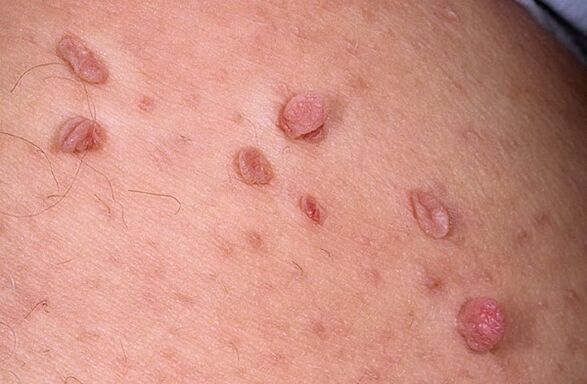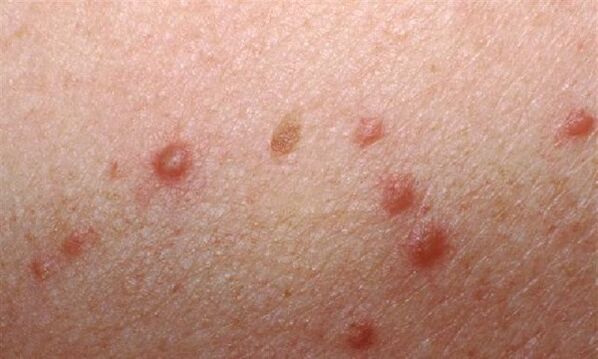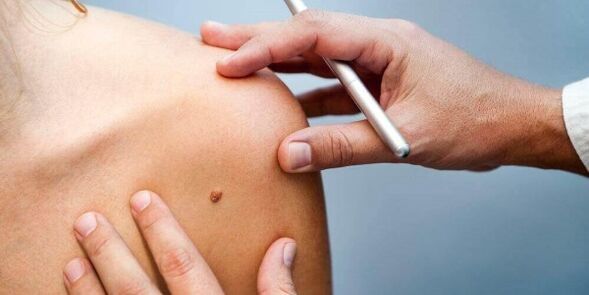The causes of papillomas on the surface of the body in women are in most cases associated with infection of the body with papillomatosis virus. There are also congenital formations that are transmitted along with genetic information from one of the parents.
What are papillomas
Papillomas are benign neoplasms on the body of women, the causes of which are the pathogenic activity of viral microorganisms of the papillomavirus family. Translated from the Latin language, "papillo - nipple" and "oma - mean a typical termination of tumors of any kind. "
Papillomas are formed from the host's own epithelial cells. On the outside, it looks like a connecting papilla with a flat, sharp, rounded or branched shape.
A distinctive feature of benign neoplasms of this type is that they are able to develop on the mucous membranes of the oral cavities, internal organs with a hollow structure, inside the nasal openings, the nasal cavities on the vocal cords.
Initially, the papilloma root is formed by squamous epithelium with gradual growth over the general skin.

The color of the tumor can vary from flesh to brown and pink. . . Localization of papillomas inside the bladder, intestines, organs of the respiratory tract can cause the development of concomitant diseases and complications.
Types of papillomas on the body in women
Depending on the location of the warts, their appearance and the reasons for their formation, different types of papillomas are distinguished. The table below shows the types of benign neoplasms of this type, indicating their properties.
| Papilloma type | Characteristics of neoplasm |
|---|---|
| Genital warts | They can be located in any part of the female body. On the outside, they look like an elongated hanging mole, which in most cases has a brown tint. |
| Papilloma vulgaris | The classic form of the manifestation of the human papillomatosis virus. The neoplasms are round in shape; they are attached to the main surface of the body on a thin and short stem. Is flesh-colored like the rest of the dermis. |
| Genital warts | The localization of neoplasms of this type is the intimate zone in men and women. Infection occurs as a result of unprotected intercourse with an infected partner. The most important location of the tumors is the circumference of the anus, labia majora and minora in women and the foreskin in men. In case of non-compliance with sanitary and hygienic standards, household pollution is possible. |
| Senile warts | Found in older women. They appear as a result of hormonal changes in the body, metabolic disorders, prolonged exposure to the sun's open rays. The main danger of this type of papilloma is the high risk of their degeneration into malignant neoplasms. |
| Plantar | Papillomas of this type are located exclusively in the area of the plantar part of the foot. Outwardly, they look like a small cauliflower head with branched inflorescences. If a woman walks a lot, wears tight shoes, the plantar warts can become inflamed, soft and cause pain. |
Almost all of the above types of papillomas are formed as a result of infection of a woman with some genotype of the human papillomavirus. The only exceptions are senile warts, which can occur due to age-related changes in the body of the elderly.
Stages and degrees of papillomas on the body in women
Like any other benign tumor, papillomas develop on a woman's body in several stages.
In this respect, the following stages of wart formation are distinguished:
- Scene 1- uncontrolled division of the squamous cell epithelium and the formation of the papilloma root, which is asymptomatic and imperceptible;
- Step 2the formation of a wart head that rises 1-1, 5 mm above the general surface of the body, if it is located at the folds of the joint, in the belt area, on the neck or under the armpits, can cause a feeling of discomfort, rubbing, skin irritation;
- Step 3there is a fully flat, rounded or elongated neoplasm having a root, a bone, a main body in the form of a head and blood supply due to the smallest capillaries connected to the rest of the epithelial tissue;
- Step 4multiple proliferation of similar papillomas, which are formed as a result of cell division of an existing neoplasm (extensive papillomatosis is dangerous with a high probability of malignant degeneration of a wart).
The stage of the skin disease is determined by the dermatologist during the examination of the patient. The method of treatment is chosen based on the diagnostic results, the type of papilloma and the degree of its development.
Papilloma symptoms
Papillomas on the body (the causes of women causing the occurrence of neoplasms are associated with infection with viral microorganisms) are single or multiple benign tumors that are easy to identify by external signs.
The symptoms of papillomatosis in women are manifested as follows:
- the appearance of a small tuber that rises above the general surface of the epithelium;
- an increase in the root of the warts, which grows larger each week;
- a foreign neoplasm appears on the body, which is characterized by a round, branched or conical shape;
- the main sites of localization of papillomas on the female body are the armpits, inner thighs, neck, skin surface below the mammary glands, groin area, perineum, genitals, back, plantar part of the leg;
- in case of prolonged exposure to the wart surface, friction and pain may occur;
- papilloma may have flesh, yellowish, pink, brown shades, which is the norm;
- Attempts to remove the neoplasm themselves do not lead to a positive result and the cut wart grows back.

The presence of such symptoms as a sudden change in the color of the warts to darker colors, the onset of an acute inflammatory process, the release of pus or blood fluid, attacks of pain, are alarming signs that are not characteristic of papillomatosis. In this case, degeneration of a benign formation into a cancerous tumor is not excluded.
Reasons for the appearance
Papillomas on the body (the causes of women causing the disease may be related to the patient's lifestyle) are a chronic dermatological pathology that appears under the influence of the following factors.
Factors for papillomas on the body:
- lead a promiscuous sex life, have intimate contacts with an infected partner without using barrier contraception;
- sharing towels, cosmetics, soap and other hygiene products with a person infected with papillomavirus;
- sharing of indoor slippers and other footwear;
- visit public showers, baths, swimming pools, open-skin steam baths that touch surfaces where viable papillomavirus virions are present;
- hormonal imbalance in the body caused by concomitant diseases of the endocrine system;
- getting a viral infection in an open wound during shaving;
- infection of a child from a sick mother during the passage of the fetus through the birth canal.
In most cases, it is not possible to determine the true cause of warts on the body. The incubation period for papillomavirus after infection varies from several days to 3 or more years.
Diagnostics
To make an accurate diagnosis in the form of papillomatosis, a woman must undergo a comprehensive examination of the body and directly the skin area where the benign neoplasm is located.
Diagnosis of papillomas takes place in several stages, namely:
- visual examination by a dermatologist;
- donation of venous blood for its biochemical examination and determination of papillomavirus virions;
- examination of the deeper epithelial layer of the wart using a dermatoscope;
- capillary blood collection for clinical analysis;
- selecting a particle papilloma for further histological examination to rule out the oncological nature of the tumor 'origin;
- supply of morning urine to determine its biochemical composition and general indicators of a woman's health.
Localization of papillomas in the intimate area, on the genitals and the perimeter of the anus may require further examination by a gynecologist as well as testing for the presence of sexually transmitted infections.
When to see a doctor
The main danger of this type of warts lies in the aesthetic defect as well as the risk of their degeneration in oncology.
It is recommended to seek the advice of a dermatologist as soon as a foreign neoplasm appears.
Early diagnosis and determination of papilloma type allows you to organize effective treatment and remove neoplasm with minimal risk of complications.
Prevention of papillomas on the body
Papillomas on the body (the causes of warts in women can be eliminated with effective preventive measures) are benign tumors that can be easily prevented by following the following rules.
E. g:
- lead an orderly, intimate life, having only one sexual partner;
- Use only your own shoes, and do not let others shoe them;
- use barrier prevention
- avoid visiting public baths, toilets, pools, showers or put your feet in rubber slippers, do not touch open body parts for surfaces on walls, door handles, tiles, sun loungers;
- use only your own cosmetics, towels, soap;
- at least once a year to undergo a preventive medical examination by a dermatologist;
- balance nutrition, sleep at least 8 hours a day, enough rest to ensure the normal functioning of the immune system.
All of the above recommendations do not guarantee 100% protection against infection with papillomatosis, but they do allow you to minimize the risk of disease and avoid contact with sources of potential infection.
Methods of treating papillomas on the body in women
Papillomatosis is a completely incurable disease. A woman who has got the virus that causes warts carries it for the rest of her life. Modern methods of treating the disease can only get rid of the consequences of pathology in the form of benign neoplasms.
Medicine
Traditional medicine does not completely get rid of papillomas, as warts of this type require removal by chemical, thermal, electrocoagulation, laser or surgical treatment.
Traditional methods
Alternative medicine offers its own alternative ways to get rid of papillomas, regardless of their type and location on the female body. The following are traditional methods of removing warts.
Knitting with a thread
It is necessary to wait until the lunar phase is in the waning phase. You will need to take a piece of black thread, use it to tie papillomas and tie a knot. This thread is taken out to the garden and buried in the ground with the words, "When this thread decays, all my warts will disappear. " After 2-3 weeks, the papilloma begins to soften and collapse with no signs of pain or inflammation.
Special funds
There are special remedies for warts and papillomas, but they do not provide the effectiveness of their action and guarantee a relapse. One of these tools is, for example, a special patch.
Such products usually contain natural ingredients that to some extent counteract the virus.
Dogs spit
To get rid of a benign neoplasm using this method, spread the wart with an even layer of sour cream. Then the woman should go to the dog so that he licks the lactic acid product with his tongue.
The papilloma is then sealed with a medicated adhesive plaster. Saliva cannot be wiped off the surface of the neoplasm. After 1 week, the patch can be removed. From this point on, the wart begins to crumble.
Moxibustion with celandine
During the growing season of this plant (from late May to mid-June), daily pick branches of celandine and cauterize the warts with poisonous yellow juice. The duration of treatment is 10 to 30 days. Precautions should be taken to prevent the juice from getting on the mucous membranes of the mouth and eyes.
The effectiveness of the use of the above folk remedies for the removal of papillomas on the body has not been proven by official science. Women who used similar recipes were able to achieve the desired result and respond positively to these treatment methods.
Other methods
The most effective way to treat papillomas is to remove them completely.
The following methods are used for this:
- chemical combustion- provides exposure to the wart surface with aggressive solutions based on acids, potassium or sodium alkali;
- electrocoagulation- the papilloma is cut off and cauterized by means of a loop-shaped instrument whose metal end is under an electric current (the treatment procedure is performed under local anesthesia);
- cryodestructiona benign neoplasm is burned out by means of a liquid nitrogen solution (under the influence of low temperatures, epithelial tissue freezes and then dissolves into parts);
- laser coagulation- excision of the papilloma is performed by means of positively charged laser particles, removal of the wart body and cauterization of its root system is ensured;
- surgical removal- the traditional and most common method of treating a dermatological disease, which consists of excising the wart with a scalpel and then applying suture material.

All the above methods of treating papillomatosis allow you to remove benign neoplasms with a minimal risk of recurrence of the disease.
The average rehabilitation period is 3 to 7 days. The safest method is laser cutting and electrocoagulation. The most painful and traumatic treatment is the traditional surgical removal of the wart.
Possible complications
In the absence of adequate response measures and treatment of papillomatosis on the body, a woman may over time face the following complications.
Possible complications:
- the appearance of similar warts on other parts of the body, indicating an increase in viral activity;
- the degeneration of the warts into a malignant cancerous tumor which can lead to death;
- the presence of similar neoplasms in the bladder, intestines, larynx, trachea, which will lead to interruption of their work, problems with urination, breathing and digestive function;
- cervical cancer (scientific studies have shown that 80% of women suffering from this disease are infected with human papillomavirus;
- an increase in the size of the warts, the creation of a cosmetic and aesthetic defect;
- damage to the neoplasm and the penetration of bacterial infection into the epithelial tissue.
To prevent the appearance of papillomas on the body in women, it is necessary to remember the reasons for their occurrence. This will preserve the health of the skin, prevent a decrease in the immune status of the pathogenic activity of the papillomavirus. The disease itself is not life-threatening, but its presence can provoke the development of serious complications.














































































